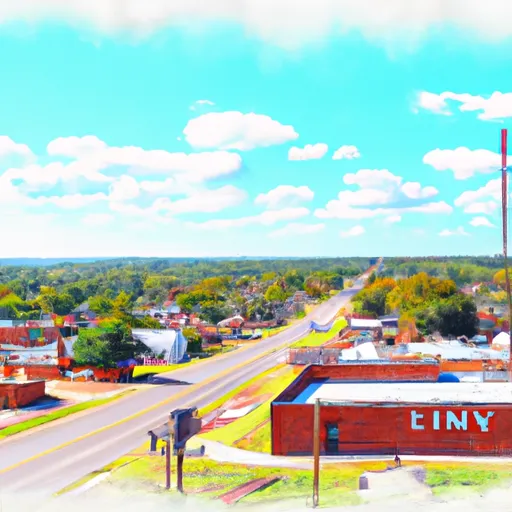-
 Snoflo Premium
Snoflo Premium
Get unlimited access to all our content
With no Ad interruptions! - Start Your Free Trial Login with existing account
Umpire
Eden Index
Climate
7.3
•
Recreation
6.9
•
Community
0.9
•
Safeguard
5.6/10

Umpire is a small town located in southwestern Arkansas, USA. The region experiences a humid subtropical climate, characterized by hot, humid summers and mild winters. The average high temperature in summer is around 90°F (32°C), while winter temperatures range from 40°F to 60°F (4°C to 15°C). Rainfall is abundant throughout the year, with an annual average of 50 inches (1270 mm), making the area lush and green.
Hydrologically, Umpire is situated in the Ouachita River basin, with various creeks and tributaries flowing through the town. These waterways offer opportunities for fishing, canoeing, and kayaking, allowing outdoor enthusiasts to explore the natural beauty of the area. The nearby Ouachita National Forest provides additional recreational activities, such as hiking, camping, and wildlife viewing. With its diverse flora and fauna, the forest is a haven for nature lovers.
In summary, Umpire, Arkansas boasts a humid subtropical climate, ample rainfall, and a hydrologically rich environment. Visitors and residents can enjoy outdoor activities like fishing, canoeing, kayaking, hiking, camping, and wildlife viewing in the surrounding area.
What is the Eden Index?
The Snoflo Eden Index serves as a comprehensive rating system for regions, evaluating their desirability through a holistic assessment of climate health, outdoor recreation opportunities, and natural disaster risk, acknowledging the profound impact of these factors on livability and well-being.
Climate Health Indicator (CHI): 7.3
Umpire receives approximately
1519mm of rain per year,
with humidity levels near 84%
and air temperatures averaging around
16°C.
Umpire has a plant hardyness factor of
7, meaning
plants and agriculture in this region tend to thrive during the non-winter months.
By considering the ideal temperature range, reliable water supplies, clean air, and stable seasonal rain or snowpacks, the Climate Health Indicator (CHI) underscores the significance of a healthy climate as the foundation for quality living.
A healthy climate is paramount for ensuring a high quality of life and livability in a region, fostering both physical well-being and environmental harmony. This can be characterized by ideal temperatures, reliable access to water supplies, clean air, and consistent seasonal rain or snowpacks.
Weather Forecast
Streamflow Conditions
Red-Little
Area Rivers
Red-Little
Snowpack Depths
Red-Little
Reservoir Storage Capacity
Red-Little
Groundwater Levels
Recreational Opportunity Index (ROI): 6.9
The Recreational Opportunity Index (ROI) recognizes the value of outdoor recreational options, such as parks, hiking trails, camping sites, and fishing spots, while acknowledging that climate plays a pivotal role in ensuring the comfort and consistency of these experiences.
Access to outdoor recreational opportunities, encompassing activities such as parks, hiking, camping, and fishing, is crucial for overall well-being, and the climate plays a pivotal role in enabling and enhancing these experiences, ensuring that individuals can engage in nature-based activities comfortably and consistently.
Camping Areas
| Campground | Campsites | Reservations | Toilets | Showers | Elevation |
|---|---|---|---|---|---|
| Oak Ridge | None | 199 ft | |||
| Boles Field | 20 | 308 ft | |||
| Mission Dolores City RV Park | 32 | 345 ft | |||
| Red Hills Lake | 26 | 374 ft | |||
| Kelly Creek Park - Lake Wright Patman | 80 | 252 ft | |||
| Caddo Lake State Park | 28 | 281 ft | |||
| Earl Williamson Park | None | 175 ft | |||
| Cass County Park | 46 | 244 ft | |||
| Atlanta State Park | 60 | 286 ft | |||
| Ragtown | 25 | 208 ft |
Nearby Ski Areas
Catastrophe Safeguard Index (CSI):
The Catastrophe Safeguard Index (CSI) recognizes that natural disaster risk, encompassing floods, fires, hurricanes, and tornadoes, can drastically affect safety and the overall appeal of an area.
The level of natural disaster risk in a region significantly affects safety and the overall livability, with climate change amplifying these risks by potentially increasing the frequency and intensity of events like floods, fires, hurricanes, and tornadoes, thereby posing substantial challenges to community resilience and well-being.
Community Resilience Indicator (CRI): 0.9
The Community Resilience Indicator (CRI) recognizes that education, healthcare, and socioeconomics are crucial to the well-being of a region. The CRI acknowledges the profound impact of these elements on residents' overall quality of life. By evaluating educational resources, healthcare accessibility, and economic inclusivity, the index captures the essential aspects that contribute to a thriving community, fostering resident satisfaction, equity, and social cohesion.

